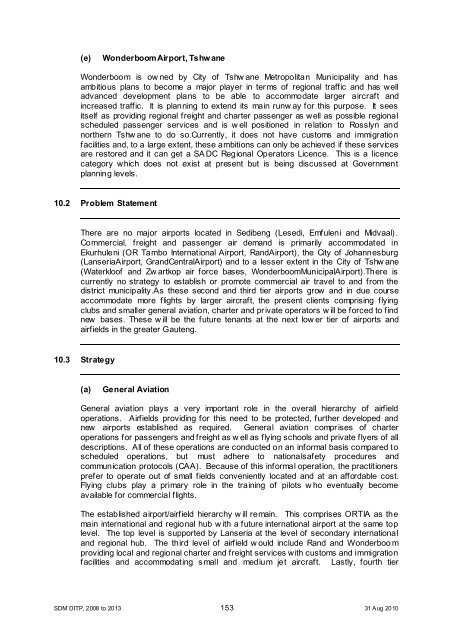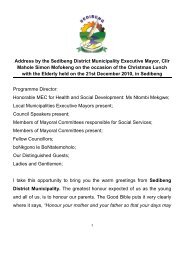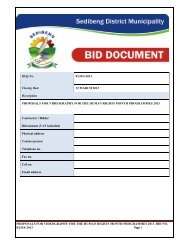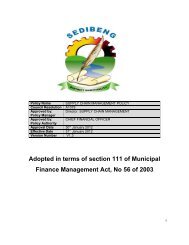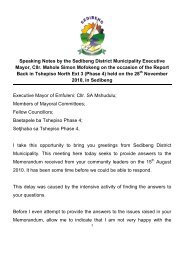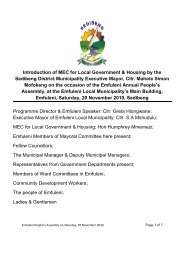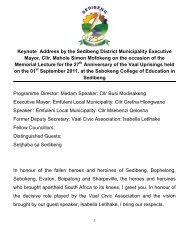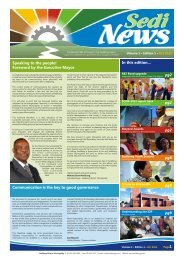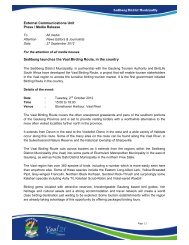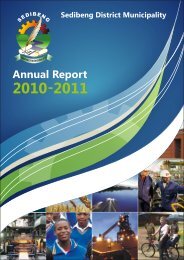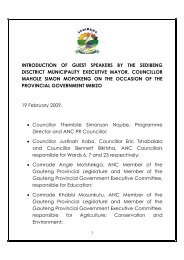Chapter 11 - Sedibeng District Municipality
Chapter 11 - Sedibeng District Municipality
Chapter 11 - Sedibeng District Municipality
Create successful ePaper yourself
Turn your PDF publications into a flip-book with our unique Google optimized e-Paper software.
(e)<br />
WonderboomAirport, Tshw ane<br />
Wonderboom is ow ned by City of Tshw ane Metropolitan <strong>Municipality</strong> and has<br />
ambitious plans to become a major player in terms of regional traffic and has well<br />
advanced development plans to be able to accommodate larger aircraft and<br />
increased traffic. It is planning to extend its main runw ay for this purpose. It sees<br />
itself as providing regional freight and charter passenger as well as possible regional<br />
scheduled passenger services and is w ell positioned in relation to Rosslyn and<br />
northern Tshw ane to do so.Currently, it does not have customs and immigration<br />
facilities and, to a large extent, these ambitions can only be achieved if these services<br />
are restored and it can get a SA DC Regional Operators Licence. This is a licence<br />
category which does not exist at present but is being discussed at Government<br />
planning levels.<br />
10.2 Problem Statement<br />
There are no major airports located in <strong>Sedibeng</strong> (Lesedi, Emfuleni and Midvaal).<br />
Commercial, freight and passenger air demand is primarily accommodated in<br />
Ekurhuleni (OR Tambo International Airport, RandAirport), the City of Johannesburg<br />
(LanseriaAirport, GrandCentralAirport) and to a lesser extent in the City of Tshw ane<br />
(Waterkloof and Zw artkop air force bases, WonderboomMunicipalAirport).There is<br />
currently no strategy to establish or promote commercial air travel to and from the<br />
district municipality.As these second and third tier airports grow and in due course<br />
accommodate more flights by larger aircraft, the present clients comprising flying<br />
clubs and smaller general aviation, charter and private operators w ill be forced to find<br />
new bases. These w ill be the future tenants at the next low er tier of airports and<br />
airfields in the greater Gauteng.<br />
10.3 Strategy<br />
(a)<br />
General Aviation<br />
General aviation plays a very important role in the overall hierarchy of airfield<br />
operations. Airfields providing for this need to be protected, further developed and<br />
new airports established as required. General aviation comprises of charter<br />
operations for passengers and freight as w ell as flying schools and private flyers of all<br />
descriptions. All of these operations are conducted on an informal basis compared to<br />
scheduled operations, but must adhere to nationalsafety procedures and<br />
communication protocols (CAA). Because of this informal operation, the practitioners<br />
prefer to operate out of small fields conveniently located and at an affordable cost.<br />
Flying clubs play a primary role in the training of pilots w ho eventually become<br />
available for commercial flights.<br />
The established airport/airfield hierarchy w ill remain. This comprises ORTIA as the<br />
main international and regional hub w ith a future international airport at the same top<br />
level. The top level is supported by Lanseria at the level of secondary international<br />
and regional hub. The third level of airfield w ould include Rand and Wonderboo m<br />
providing local and regional charter and freight services with customs and immigration<br />
facilities and accommodating s mall and medium jet aircraft. Lastly, fourth tier<br />
SDM DITP, 2008 to 2013 153 31 Aug 2010


